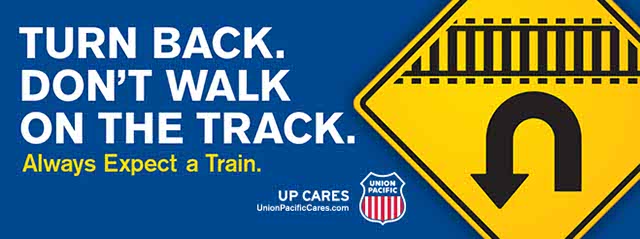September 21, 2021
11 Train Facts that Could Save Your Life
Operation Lifesaver is a non-profit dedicated to rail safety education with the goal of preventing collisions, injuries and fatalities on and around railroad tracks and crossings. Every September, the organization holds Rail Safety Week, a week of awareness activities designed to help prevent track tragedies. Rail Safety Week is a time to raise awareness about the importance of rail safety education and empower the public to keep themselves safe in the presence of railroad tracks.
In honor of this important week, we’re sharing these 11 facts you may not know about trains — because they may just save your life.
Fact #1: Track Tragedies Happen More Often Than You Think
Every three hours, a person or vehicle is hit by a train in the United States. However, many of these are preventable. This is one of the many reasons why being educated about rail safety is so important.

Fact #2: Railroad Tracks Are Private Property
Walking on train tracks may seem like fun, but it’s actually very dangerous, not to mention illegal. All train tracks are private property, so pedestrians should never walk on or near them.
Fact #3: A Train Can Pass at Any Time
Freight trains don't travel at fixed times, and schedules for passenger trains often change. So even if you’ve never seen a train on the tracks you’re crossing, always expect a train.

Fact #4: Trains Can Stop, But Not Quickly
It takes the average freight train traveling at 55 mph more than a mile to stop. That’s the length of 18 football fields. So if you think a train can see you and stop in time, think again. Trains cannot stop quickly enough to avoid a collision, which is why vehicles should never drive around lowered gates or try to “beat” a train.
Fact #5: Vehicles Are No Match for Locomotives
The average locomotive weighs about 200 tons (400,000 pounds) but can weigh up to 6,000 tons. That means the weight ratio of a car to a train is proportionate to that of a soda can to a car. Imagine running over an aluminum can with your vehicle — you don’t want that to be the case for a locomotive and your car.
Fact #6: Trains Always Have the Right of Way
Trains can’t stop on a dime or pull over to the side. So even in the presence of emergency vehicles, the police or pedestrians, they have the right of way every time. That includes cars, too.

Fact #7: Trains Are Bigger than Tracks
People may think they can stand alongside tracks and be safe from a train, but the truth is trains are wider than the tracks. A train can extend three or more feet on either side of the steel rail, so the safe zone for pedestrians is well beyond three feet on either side. And when vehicles are stopped at a designated crossing, they should remain 15 feet or more from a rail.
Fact #8: Trains Travel in Both Directions
Tracks aren’t one way, so even if you’ve seen a train traveling east, a train could travel west on the very same track. It’s also important to keep in mind that locomotives can both push and pull rail cars, so the location of the locomotive isn’t always an indicator of which direction the train is traveling.
Fact #9: Trains Can Sneak Up on You
An optical illusion makes it hard to determine both a train's distance from you and its speed. At the same time, trains are quieter than ever, so just because you don’t hear that "clackety-clack” doesn’t mean a train is far away. For these reasons, trains are always closer and moving faster than you think.

Fact #10: Designated Crossings Are the Only Safe Place to Cross
The only safe (and legal) place to cross railroad tracks is at designated railroad crossings. It’s important to cross train tracks ONLY at designated pedestrian or roadway crossings and obey all warning signs and signals posted there.
Fact #11: Trespassing and Grade Crossing Collisions Are the Biggest Cause of Rail-Related Fatalities
According to data from the Federal Railroad Administration (FRA), 9 out of 10 rail-related fatalities involve grade crossing collisions or incidents with trespassers. Staying off tracks and paying extra attention at railroad crossings are the best steps pedestrians and drivers can take to save their lives.
Learn More
To learn more about rail safety, consult Operation Lifesaver’s safety tips for drivers and pedestrians. Or, check out the National Highway Traffic Safety Administration’s (NHTSA) “7 Steps for Navigating Freight and Commuter Train Crossings.” To see Union Pacific’s safety resources, visit our Safety page.
If you'd like to learn more about shipping by rail, answer a few questions and we'll connect you with an expert.
Related Articles
- Railroad Safety: Train Horns and Grade Crossing Signals
- How Do Railroads Keep Cross-Border Shipments Safe?
- The Impact of Black Inventors on the Railroad
- Transportation Modes Revealed: Rail
- Rail 101 FAQs
- Rail Car Types Defined
- The Best Railroad Resources
- U.S. Freight Rail: The Envy of the World
- Home Sweet Home: Brought to You by Rail
- How Much Freight Ships by Rail In the US?
- Railroad Terms and Definitions Translated: English and Spanish // Términos y definiciones del ferrocarril Traducido: Inglés y español
- Quiz: Can Your Product Ship by Rail?